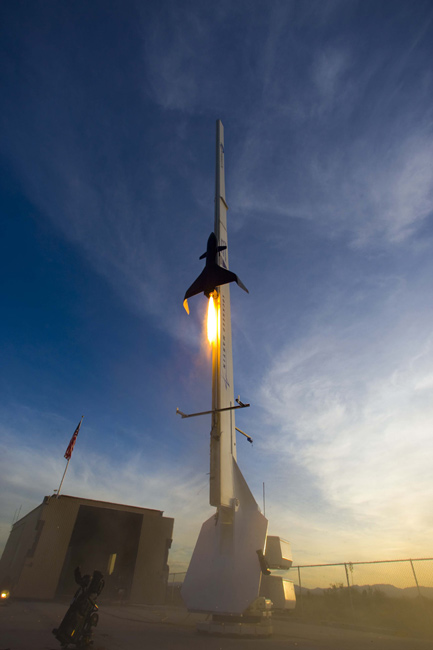Space Plane Prototype Suffers Anomaly in Launch Test

GOLDEN,Colorado — Lockheed Martin carried out a second test flight of a prototypereusable launch system on Aug. 12 at the proposed site of New Mexico?sSpaceport America outside of Las Cruces, New Mexico.
While the200-pound (91 kg) vehicle reached its planned altitude — roughly 1,500 feet(457 meters) — the craft went out of control and was seriously damaged, beyondreusability.
Liftoffof the proprietary winged craft tookplace in the early morning hours at the site, zipping up a launch railunder its own power and headed skyward.
The rocketplane flew some 12.5 seconds of a planned flight of less than a minute beforeexperiencing the in-flight anomaly, said Al Simpson, acting director, AdvancedPrograms, Human Space Flight for Lockheed Martin Space Systems Company, nearDenver.
?We?reinvestigating right now?to ascertain what happened. That?s the research and developmentnature of what we?re trying to do,? Simpson told SPACE.com. ?We?re goingto go off and look and see what happened and then crank that back into our nextflight,? he said.
Fullyautonomous vehicle
Theself-propelled vehicle was flownlast December from the same launch area — a test effort that is being done inpartnership with UP Aerospace of Highlands Ranch, Colorado.
Breaking space news, the latest updates on rocket launches, skywatching events and more!
Simpsonsaid the name of the project, as well as the craft?s propulsion system remainsunder wraps at this time. The vehicle flown in December and now this month is 8feet (2.4 meters) long with a wingspan of about 6 feet (1.8 meters), he noted.
Severalnew test objectives were involved in the vehicle?s second flight, specificallyin the arena of autonomous flight and avionics, Simpson said.
?Thisis a fully autonomous vehicle. We?re working the autonomous liftoff, controland landing aspects of the vehicle,? Simpson explained. When the craft departsits launch rail, there?s no human in the loop, with the flight hardware sensingits environment, including winds, to guide itself on a pre-loaded trajectory totouchdown.
Forthis experimental launch, SpaceportAmerica officials had prepared a dirt landing location. But once the rocketplane diverted from its intended path, Simpson said, it plopped down aboutone-half mile down range — within spaceport grounds. ?
?Wehave another vehicle that?s nearly ready to go. We?ll learn from Tuesday?sflight and take corrective actions,? Simpson said. ?Although we didn?t like theend result, we learned a lot and will crank that into the next flight and keepgoing ? that?s my message.?
Flieslike a rocket, lands like a plane
Simpsonsaid that the vehicle flies like a rocket but lands like a plane. The roughlyone-fifth scale rocket plane is being flown to evaluate techniques andprocedures for responsiveness to quick launch, ease of operations, and low costaccess to space.
Regardingthe scaling up of the craft, Simpson said that he and his team want to take onemore step by the end of next year. ?The philosophy is to test a little, fly alittle?and buy down the risk? in a venture to address the nation?s needs forresponsive, low-cost access to space, he said.
Ultimately,the autonomously controlled, sub-scale unpiloted space plane project isintended to lead to the fielding of a larger-scale system, one that lowers theprice tag of lofting satellites into Earth orbit.
At theend of 2010, early 2011, Simpson added, project officials want to amass a bodyof data from the test shots that would be available to say ?should we goforward and ?operationalize? something like this??
?Thetheme here is trying to do something a little bit differently than the 10-yeardevelopment program,? Simpson concluded.
- Video - Falcon 1's Third Flight
- Video - Coming Soon: The Final Flight to Hubble
- Images - 20 Great Rocket Launches

Leonard David is an award-winning space journalist who has been reporting on space activities for more than 50 years. Currently writing as Space.com's Space Insider Columnist among his other projects, Leonard has authored numerous books on space exploration, Mars missions and more, with his latest being "Moon Rush: The New Space Race" published in 2019 by National Geographic. He also wrote "Mars: Our Future on the Red Planet" released in 2016 by National Geographic. Leonard has served as a correspondent for SpaceNews, Scientific American and Aerospace America for the AIAA. He has received many awards, including the first Ordway Award for Sustained Excellence in Spaceflight History in 2015 at the AAS Wernher von Braun Memorial Symposium. You can find out Leonard's latest project at his website and on Twitter.
